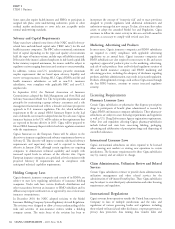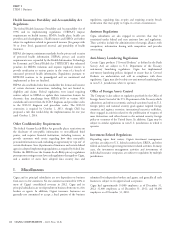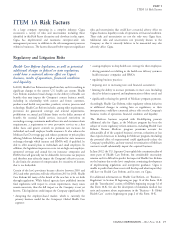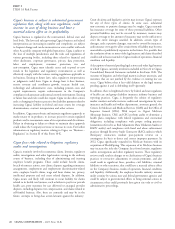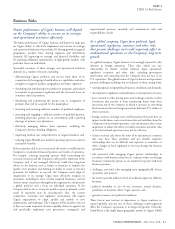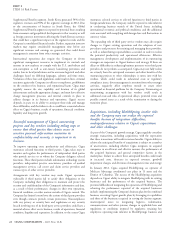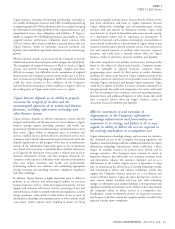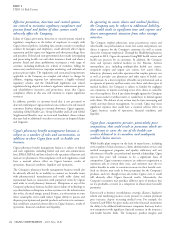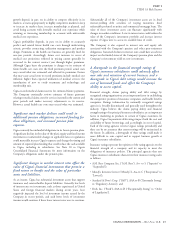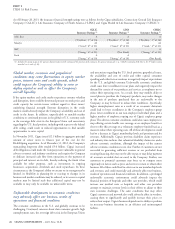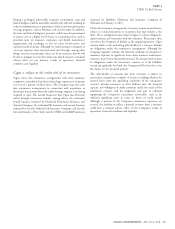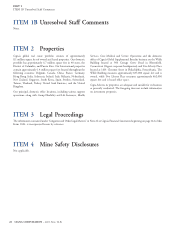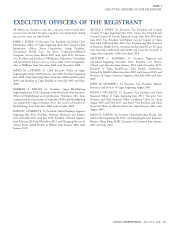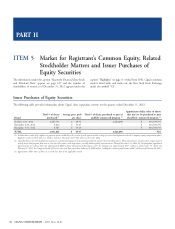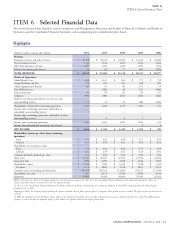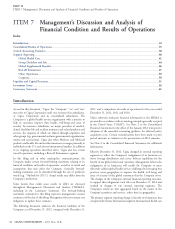Cigna 2012 Annual Report Download - page 48
Download and view the complete annual report
Please find page 48 of the 2012 Cigna annual report below. You can navigate through the pages in the report by either clicking on the pages listed below, or by using the keyword search tool below to find specific information within the annual report.
PART I
ITEM 1A Risk Factors
As of February 28, 2013, the insurance financial strength ratings were as follows for the Cigna subsidiaries, Connecticut General Life Insurance
Company (‘‘CGLIC’’), Life Insurance Company of North America (‘‘LINA’’) and Cigna Health & Life Insurance Company (‘‘CHLIC’’):
CGLIC LINA CHLIC
Insurance Ratings
(1)
Insurance Ratings
(1)
Insurance Ratings
(1)
A.M. Best A A A
(‘‘Excellent,’’ 3
rd
of 16) (‘‘Excellent,’’ 3
rd
of 16) (‘‘Excellent,’’ 3
rd
of 16)
Moody’s A2 A2 A2
(‘‘Good,’’ 6
th
of 21) (‘‘Good,’’ 6
th
of 21) (‘‘Good,’’ 6
th
of 21)
S&P AA
(‘‘Strong,’’ 6
th
of 21) (Not Rated) (‘‘Strong,’’ 6
th
of 21)
Fitch AA
(‘‘Strong,’’ 6
th
of 19) (‘‘Strong,’’ 6
th
of 19) (Not Rated)
(1) Includes the rating assigned, the agency’s characterization of the rating and the position of the rating in the agency’s rating scale (e.g., CGLIC’s rating by A.M. Best is the 3
rd
highest rating
awarded in its scale of 16).
and uncertainty regarding the U.S. fiscal position, geopolitical issues,
Global market, economic and geopolitical
the availability and cost of credit and other capital, consumer
conditions may cause fluctuations in equity market
spending and other factors continue to negatively impact expectations
prices, interest rates and credit spreads, which
for the U.S. and global economy. Unfavorable economic conditions
could impact the Company’s ability to raise or
could cause lower enrollment in our plans and negatively impact the
deploy capital as well as affect the Company’s
demand for certain of our products and services as employers try to
overall liquidity.
reduce their operating costs. As a result, they may modify, delay or
cancel plans to purchase the Company’s products, may make changes
If the equity markets and credit market experience extreme volatility in the mix of products purchased that are unfavorable to the
and disruption, there could be downward pressure on stock prices and Company, or may be forced to reduce their workforces. Specifically,
credit capacity for certain issuers without regard to those issuers’ higher unemployment rates as a result of an economic downturn
underlying financial strength. Extreme disruption in the credit could lead to lower enrollment in the Company’s employer group
markets could adversely impact the Company’s availability and cost of plans, lower enrollment in our non-employer individual plans and a
credit in the future. In addition, unpredictable or unstable market higher number of employees opting out of Cigna’s employer group
conditions or continued pressure in the global or U.S. economy, such plans. The adverse economic conditions could also cause employers to
as the sovereign debt crisis in the European Union and uncertainty stop offering certain health care coverage as an employee benefit or
regarding the U.S. fiscal position, including with respect to the federal elect to offer this coverage on a voluntary, employee-funded basis as a
debt ceiling, could result in reduced opportunities to find suitable means to reduce their operating costs. All of these developments could
opportunities to raise capital. lead to a decrease in Cigna’s membership levels and premium and fee
In November 2011, Cigna issued $2.1 billion in aggregate principal revenues. Additionally, Cigna’s previous disability claim experience
amount of senior notes to finance part of the cost for the and industry data indicate that submitted disability claims rise under
HealthSpring acquisition. As of December 31, 2012, the Company’s adverse economic conditions, although the impact of the current
outstanding long-term debt totaled $5.0 billion. Cigna’s increased adverse economic conditions is not clear. Further, if customers are not
debt obligations could make the Company more vulnerable to general successful in generating sufficient revenue or are precluded from
adverse economic and industry conditions and require the Company securing financing, they may not be able to pay, or may delay payment
to dedicate increased cash flow from operations to the payment of of, accounts receivable that are owed to the Company. Further, our
principal and interest on its debt, thereby reducing the funds it has customers or potential customers may force us to compete more
available for other purposes, such as investments in ongoing vigorously on factors such as price and service to retain or obtain their
businesses, acquisitions, dividends and stock repurchases. In these business. All of these could lead to a decrease in our membership levels
circumstances, the Company’s ability to execute on its strategy may be and revenues, and could materially and adversely affect our business,
limited, its flexibility in planning for or reacting to changes in its results of operations and financial condition. In addition, a prolonged
business and market conditions may be reduced, or its access to capital unfavorable economic environment could adversely impact the
markets may be limited such that additional capital may not be financial position of hospitals and other care providers, which could
available or may only be available on unfavorable terms. increase our medical costs as hospitals and other care providers
attempt to maintain revenue levels in their efforts to adjust to their
own economic challenges. The same conditions that may affect
Unfavorable developments in economic conditions
Cigna’s customers and network also could adversely affect its vendors,
may adversely affect our business, results of
causing them to significantly and quickly increase their prices or
operations and financial condition.
reduce their output. Cigna’s business depends on its ability to perform
its necessary business functions in an efficient and uninterrupted
The economic conditions in the U.S. and globally continue to be fashion.
challenging. Continued concerns about slow economic growth, high
unemployment rates, the sovereign debt crisis in the European Union
26 CIGNA CORPORATION - 2012 Form 10-K


